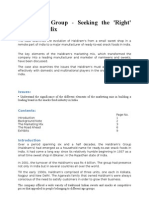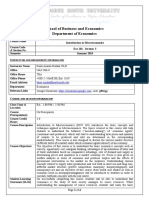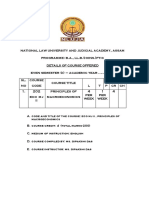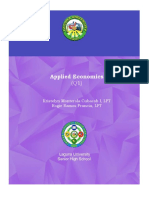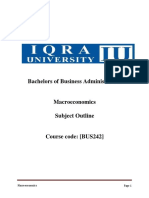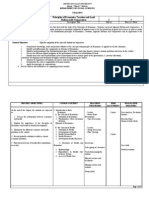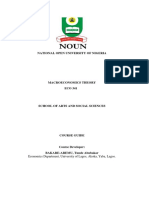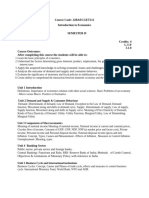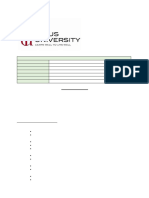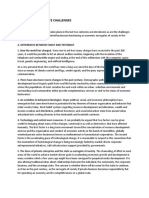UPDATED - SYLLABUS-ECONTAX (2) .Odt
UPDATED - SYLLABUS-ECONTAX (2) .Odt
Uploaded by
Precilla ZoletaCopyright:
Available Formats
UPDATED - SYLLABUS-ECONTAX (2) .Odt
UPDATED - SYLLABUS-ECONTAX (2) .Odt
Uploaded by
Precilla ZoletaOriginal Title
Copyright
Available Formats
Share this document
Did you find this document useful?
Is this content inappropriate?
Copyright:
Available Formats
UPDATED - SYLLABUS-ECONTAX (2) .Odt
UPDATED - SYLLABUS-ECONTAX (2) .Odt
Uploaded by
Precilla ZoletaCopyright:
Available Formats
Course Code: ECONTAX
Course Name : Economics with Agrarian Reform and Taxation
Course Description: This course gives the students an overview of microeconomics,
macroeconomics, taxation, and agrarian reform as applied in the
Philippine setting.
Course Credit: 3.0 units
Course Prerequisite: none
Objectives: General :
At the end of the course, the students are expected to understand how
the basic principles of economics, land reform and taxation will aid
them in managerial decision-making and becoming good citizens.
Specific :
The students are also expected to be able to:
1.explain basic concepts such as economic systems, opportunity costs,
demand and supply, elasticity, factors of production, household/
firm behavior and choice, production, cost, profit, revenue, types
of market structure, national income, consumption, savings,
unemployment, inflation, monetary policy, fiscal policy, agrarian
reform and taxation.
2. construct and interpret graphs
3. solve decision problems applying the tools of Economics
MODULES
Topic 1 : Microeconomics
Objectives : At the end of this topic, the students are expected to be able to :
1. identify the basic economic problems that any economy must face.
2. identify the different types of resources available to an economy and develop awareness
of
how scarce they are.
3. state the concept of scarcity and opportunity cost and illustrate it by constructing a
production possibility frontier (ppf).
4. state the law of supply and demand and illustrate how equilibrium price and quantity is
determined.
5. state the concept of elasticity and use it in pricing decisions.
ECONTAX School of Accountancy and Business Page 1 of 5
Learning Activities :
1. Lecture - Discussion
2. Proper Assignment of Tasks based on Opportunity Cost
3. Construction of Graphs
4. Computation of equilibrium price and quantity
5. Computation of elasticity
6. Computation of optimum quantity of production
WEEK 1
Modules 1–3 Historical Background of Economics
Module 4 Goals of Economics
Module 5 Branches of Economics
Module 6 The Economic System
WEEK 2
Modules 7 – 8 Elements of Demand and Supply
Module 9 Market Equilibrium
Modules 10 – 12 Quiz No. 1
WEEK 3
Modules 13 – 15 Concept of Elasticity
Modules 16 – 18 Consumer Behavior
WEEK 4
Modules 19 – 20 Concept of Production
Module 21 Analysis of Cost, Profit and Total Revenue
Modules 22 – 24 Quiz No. 2
WEEK 5
Module 25 Perfect Competition
Modules 26 – 27 Non-Perfect Competition (Monopoly, Oligopoly, Oligopolistic
Competition)
Modules 28 – 30 Quiz No. 3
Topic 2 : Macroeconomics
Objectives : At the end of this topic, the students are expected to be able to :
1. establish the link between microeconomics and macroeconomics.
2. understand how the health of a nation’s economy is measured.
3. understand the issues related to unemployment and generate ideas on how to attain full
employment of the labor force.
Learning Activities :
1. Lecture - Discussion
2. Construction of Graphs
ECONTAX School of Accountancy and Business Page 2 of 5
3. Computation of GDP, GNP, Unemployment and Inflation
4. Ranking of Countries in terms of Gross National Income
WEEK 6
Modules 31 – 32 Measuring the Economy
Modules 33 – 34 Gross Domestic Product (GDP) / Gross National Product (GNP)
Module 35 Consumption and Savings
Module 36 Aggregate Expenditure Model
WEEK 7
Module 37 Business Cycle
Modules 38 – 39 Unemployment and Inflation
Modules 40 – 42 Quiz No.4
Topic 3 : International Economics
Objectives : At the end of this topic, the students are expected to be able to :
1. outline how a country’s economic activities are affected by the world economy.
2. understand the rationale behind the government’s monetary and fiscal policies.
Learning Activities :
1. Lecture - Discussion
2. Conversion of domestic currency to foreign currencies
WEEK 8
Module 43 Theoretical Bases of International Trade
Module 44 Need for Trade Protection of Developing Nations
Module 45 Types of Trade Protections
Module 46 Arguments for the Imposition of Tariff Protections
Module 47 The Foreign Exchange Market
Module 48 Balance of Payments
WEEK 9
Modules 49 – 51 Monetary Policy / Fiscal Policy
Modules 52 – 54 Quiz 5
Topic 4 : Taxation
Objectives: At the end of this topic, the students are expected to be able to :
1. accept one’s obligation to pay the correct amount of taxes.
2. compute personal income tax.
Learning Activities :
1. Lecture - Discussion
2. Computation of Personal Income Tax
3. News Analysis about Tax Evasion Cases
WEEK 10
ECONTAX School of Accountancy and Business Page 3 of 5
Modules 55 – 56 Principles and Theories of Taxation
Module 57 Forms of Escape from Taxation
Module 58 Tax Remedies of the Government
Modules 59 - 60 Computation of Personal Income Tax
Topic 5 : Agrarian Reform
Objectives : At the end of this topic, the students are expected to be able to :
1. understand the plight of farmers clamoring for true agrarian reform.
2. form opinions and generate ideas for an effective implementation of agrarian reform.
Learning Activities :
1. Lecture – Discussion
2. News Analysis about the implementation of the Comprehensive Agrarian Reform
Program
(CARP)
WEEK 11
Modules 61 – 63 Principles Behind Agrarian Reform
Modules 64 – 65 Agrarian Reform in the Philippines
Module 66 Funding Sources of Comprehensive Agrarian Reform
WEEK 12
Module 67 Procedure of Land Acquisition
Module 68 Land Distribution
Module 69 Payment by Beneficiaries
Modules 70 – 72 Quiz No. 6
WEEK 13
Modules 73– 78 Project Presentation
WEEK 14 Final Exam
Textbook: Gabay, B. K. G., Remotin, R. M., Jr., & Uy, E. A. (2012). Economics: its concepts and
principles (with Agrarian Reform and Taxation)(2nd ed.). Manila: Rex
Bookstore.
References: Case, K. E., & Fair, R. C., (2011). Principles of economics. (10th ed.). Singapore:
Pearson Education.
Villegas, B. (2010). Guide to economics for Filipinos. Manila: Sinag-tala Pub.
Peter, J.P. (2010). Consumer behavior & marketing strategy. (9th ed.) Boston :
McGraw.
Duncano, D.A. (2010). Philippines taxation handbook : a simplified course. Manila :
National Book Store.
Bello, A. L., Bello, R. T., Camacho, J. DV. , Jr., Catelo, M. A. O., Cuevas, A. C., &
Rodriguez, U. E. (2009). Economics. Quezon City: C & E Publishing.
Manapat, C.L., Olaguer, RJ.A., Pedrosa, F.R. (2010). Economics, taxation, and
agrarian
reform. Quezon City: C & E Publishing.
ECONTAX School of Accountancy and Business Page 4 of 5
Web References : www.prenhall.com/casefair
Instructional Strategies : Lectures, Class Discussions, Debates, Graphing, Major Examinations,
Projects
Grading System:
Class Standing, 1st half (quizzes, assignments, participation) 20%
Midterm Exam 20%
Class Standing, 2nd half (quizzes, assignments, participation) 20%
Group Project (written report and oral defense) 20%
Written Final Exam 20%
-----
Total 100%
Passing Grade 70%
1. Each module is a 30-minute classroom instruction.
2. MTH/TF/WS classes will have to finish 2-3 modules per session.
3. A 30-minute consultation period is allotted per week.
4. A student is considered late, and is considered half-absent, if he/she arrives in class
after the official
start time but within the allowable period of 30 minutes.
5. A student is considered absent from class if he is not present within the first 30
minutes of the
scheduled class session.
6. A maximum of 5 absences is allowed; beyond this, a student is considered deficient
in course
requirements, and is given a grade of 0.0 (Fail).
rfontanosa/vmercado/cibañez 05/06/13
ECONTAX School of Accountancy and Business Page 5 of 5
You might also like
- Pcem 06 Swot Analysis Kaha FinalDocument23 pagesPcem 06 Swot Analysis Kaha Finalziad0% (1)
- Economic Analysis For Business DecisionsDocument6 pagesEconomic Analysis For Business DecisionsG NagarajanNo ratings yet
- Course 1A Introduction To Economics Course Code Credit Points FHEQ Level Prerequisites Faculty Course LeaderDocument5 pagesCourse 1A Introduction To Economics Course Code Credit Points FHEQ Level Prerequisites Faculty Course LeaderMello Jane Garcia DedosinNo ratings yet
- Pitong KuwentoDocument113 pagesPitong KuwentoPrecilla Zoleta100% (1)
- Haldiram - Mktg. MixDocument3 pagesHaldiram - Mktg. MixManjusha100% (2)
- UNWTO Tourism 2020Document28 pagesUNWTO Tourism 2020Sofija Petronijevic100% (1)
- 100000IF21 EconomiaGeneralIndDocument5 pages100000IF21 EconomiaGeneralIndAllison Yanina Rodriguez CcorcaNo ratings yet
- ECO101 Course Outline KNZ, Summer 2019Document4 pagesECO101 Course Outline KNZ, Summer 2019Lutfun Nesa Aysha 1831892630No ratings yet
- Principles of EconomicsDocument10 pagesPrinciples of EconomicsClaire E JoeNo ratings yet
- School of Business and Economics Department of EconomicsDocument4 pagesSchool of Business and Economics Department of EconomicsEmon ChowdhuryNo ratings yet
- Nep EcoDocument62 pagesNep EcoBhupesh BagNo ratings yet
- EconomicsDocument6 pagesEconomicsmohammedNo ratings yet
- ECO101.48 Course OutlineDocument6 pagesECO101.48 Course OutlineShagufta ChowdhuryNo ratings yet
- How To Use This ModuleDocument5 pagesHow To Use This ModuleApril Joy DelacruzNo ratings yet
- Economics Course Structure NEP 2020PDF - 240825 - 183343Document62 pagesEconomics Course Structure NEP 2020PDF - 240825 - 183343krishnagardia5No ratings yet
- Ba Hons Economics SyllabusDocument33 pagesBa Hons Economics SyllabusParul JainNo ratings yet
- 202 Eco Maj IIDocument5 pages202 Eco Maj IIKunalNo ratings yet
- CECN104, Course OutlineDocument23 pagesCECN104, Course OutlinePhat Nguyen ThanhNo ratings yet
- Economics-Asam MammadovDocument3 pagesEconomics-Asam MammadovHasan RahimliNo ratings yet
- NLUJS PRINCIPLES OF MICROECONOMICS LIST OF bOOKSDocument5 pagesNLUJS PRINCIPLES OF MICROECONOMICS LIST OF bOOKSRicha sharmaNo ratings yet
- Course Outline EconomicsDocument2 pagesCourse Outline EconomicsbelachewlidiyaNo ratings yet
- Course Outline For ECO 101Document5 pagesCourse Outline For ECO 101Muhammed AuwalNo ratings yet
- Micro Economics LW1117Document7 pagesMicro Economics LW1117orinluna03No ratings yet
- Minor Business Economics III 1Document7 pagesMinor Business Economics III 1anonymous0unNo ratings yet
- AttachmentDocument5 pagesAttachmentjarsogelma766No ratings yet
- S M C L: Aint Ichael'S Ollege of AgunaDocument3 pagesS M C L: Aint Ichael'S Ollege of AgunaAnjo Espela VelascoNo ratings yet
- Applied EconomicsDocument53 pagesApplied EconomicsTom VargasNo ratings yet
- H11EB-rebrandDocument10 pagesH11EB-rebrandzamirNo ratings yet
- 5.1 General Principles of Economics - by Mr. Akash ShahapureDocument5 pages5.1 General Principles of Economics - by Mr. Akash ShahapureParag KabraNo ratings yet
- Macroeconomics Course Outline - Fall 2020Document10 pagesMacroeconomics Course Outline - Fall 2020Syeda WasqaNo ratings yet
- Basic Economics With Taxation and Agrarian Reform: Dr. Vicente S. Betarmos, JRDocument11 pagesBasic Economics With Taxation and Agrarian Reform: Dr. Vicente S. Betarmos, JRPlatero RolandNo ratings yet
- M E EC-210: Icro ConomicsDocument7 pagesM E EC-210: Icro ConomicsRana HaiderNo ratings yet
- SOC. SCI. 2 SyllabusDocument10 pagesSOC. SCI. 2 SyllabusMark Angelo S. Enriquez67% (3)
- Eco 341Document179 pagesEco 341Akinyemi IbrahimNo ratings yet
- Course Outline 101Document5 pagesCourse Outline 101api-538659348No ratings yet
- ECO450: Public Finance: Qmasood@iba - Edu.pkDocument5 pagesECO450: Public Finance: Qmasood@iba - Edu.pkomer tariqNo ratings yet
- Managerial Economics - PrelimDocument39 pagesManagerial Economics - PrelimEscalante, Alliah S.No ratings yet
- Admas University Faculty of Business: Department of Accounting and Finance Course OutlineDocument5 pagesAdmas University Faculty of Business: Department of Accounting and Finance Course Outlineeyob astatkeNo ratings yet
- AP Micro Syllabus - 20222023Document11 pagesAP Micro Syllabus - 20222023Sarah SeeharNo ratings yet
- Macro Econ - 1st Sem19Document4 pagesMacro Econ - 1st Sem19MicheleNo ratings yet
- ECON F211 - POE HandoutDocument4 pagesECON F211 - POE HandoutzelylvudbnspqyocdyNo ratings yet
- Course OutlineDocument7 pagesCourse OutlineBUND FAADNo ratings yet
- UG Syllabus Department of EconomicsDocument61 pagesUG Syllabus Department of Economicsramukaka777787No ratings yet
- 5 MACRO ECONOMIC - ANALYSIS - Revised - After BoardDocument7 pages5 MACRO ECONOMIC - ANALYSIS - Revised - After BoardSUPRIYO BANERJEENo ratings yet
- Advanced Macroeconomic TheoryDocument156 pagesAdvanced Macroeconomic TheorySolomon JamesNo ratings yet
- INTRODUCTION TO ECONOMICS SYLLABUSDocument2 pagesINTRODUCTION TO ECONOMICS SYLLABUSAkshitaNo ratings yet
- MECO 111 - course outlineDocument4 pagesMECO 111 - course outlineShara xxNo ratings yet
- ECO101_Summer 2024_Course outline-1-1Document5 pagesECO101_Summer 2024_Course outline-1-1i4658764No ratings yet
- Economics 2018Document5 pagesEconomics 2018Ali Shaharyar ShigriNo ratings yet
- UFM ECO101 Subject (Approved)Document10 pagesUFM ECO101 Subject (Approved)Bảo NgọcNo ratings yet
- Course Guide 35807 Introductory Economics: Previous Previous KnowledgeDocument4 pagesCourse Guide 35807 Introductory Economics: Previous Previous KnowledgeamparoNo ratings yet
- Bhum103l - Micro-Economics - TH - 1.0 - 71 - Bhum103l - 66 AcpDocument2 pagesBhum103l - Micro-Economics - TH - 1.0 - 71 - Bhum103l - 66 AcpDarshilNo ratings yet
- Course Outline: Financial Markets and The EconomyDocument3 pagesCourse Outline: Financial Markets and The EconomyHanan ILyasNo ratings yet
- Power School of Technology: Basic Microeconomics - Course SyllabusDocument3 pagesPower School of Technology: Basic Microeconomics - Course Syllabusdashyyy 0129No ratings yet
- Introduction To Economics CCDocument3 pagesIntroduction To Economics CCtheirontemple03No ratings yet
- 2-Fundamentals of Economics - Prof. Rayees Ahmad SheikhDocument5 pages2-Fundamentals of Economics - Prof. Rayees Ahmad SheikhAkash GangwarNo ratings yet
- UFM ECO101 Subject Outline - September 2023 SemesterDocument9 pagesUFM ECO101 Subject Outline - September 2023 SemesterlolibuterflyNo ratings yet
- Assignment Brief MacroeconomicsDocument2 pagesAssignment Brief MacroeconomicsFalcon SecurityNo ratings yet
- Syllabus Applied MicroeconomicsDocument11 pagesSyllabus Applied Microeconomicstramnguyen.31221026352No ratings yet
- EconomicsDocument5 pagesEconomicskmelaku895No ratings yet
- Eco 101 Course Outline Fall 2020Document4 pagesEco 101 Course Outline Fall 2020api-536471746No ratings yet
- Economics Course Outline LAW ECON 1101Document3 pagesEconomics Course Outline LAW ECON 1101Farooq e AzamNo ratings yet
- ECO225Y D. DebrechtDocument5 pagesECO225Y D. DebrechtSling ShotNo ratings yet
- School Form 1 (SF 1)Document6 pagesSchool Form 1 (SF 1)Precilla ZoletaNo ratings yet
- School Form 1 (SF 1)Document6 pagesSchool Form 1 (SF 1)Precilla ZoletaNo ratings yet
- School Form 1 (SF 1)Document6 pagesSchool Form 1 (SF 1)Precilla ZoletaNo ratings yet
- School Form 1 (SF 1)Document6 pagesSchool Form 1 (SF 1)Precilla ZoletaNo ratings yet
- School Form 1 (SF 1)Document6 pagesSchool Form 1 (SF 1)Precilla ZoletaNo ratings yet
- Why Use Big BooksDocument1 pageWhy Use Big BooksPrecilla ZoletaNo ratings yet
- Sf1 - 2019 - Grade 7 (Year I) - 104 - MarigoldDocument6 pagesSf1 - 2019 - Grade 7 (Year I) - 104 - MarigoldPrecilla ZoletaNo ratings yet
- CIDAMDocument1 pageCIDAMPrecilla ZoletaNo ratings yet
- Cycling Is More Environmentally Friendly Than Other Forms of Transport. Why Is It Not Popular in Many Places? and How To Increase Its Popularity?Document4 pagesCycling Is More Environmentally Friendly Than Other Forms of Transport. Why Is It Not Popular in Many Places? and How To Increase Its Popularity?long leeNo ratings yet
- Chapter 1: Corporate ChallengesDocument22 pagesChapter 1: Corporate ChallengesRoselynne GatbontonNo ratings yet
- Oneplus Protect by Servify (Damage Protection Plan For Oneplus 6T)Document2 pagesOneplus Protect by Servify (Damage Protection Plan For Oneplus 6T)Praveen RamrakhiyaniNo ratings yet
- opportunity cost theoryDocument5 pagesopportunity cost theoryŠamŘeeň ŠaeedNo ratings yet
- Social InsuranceDocument2 pagesSocial Insurancebeena antuNo ratings yet
- T7 B10 Arestegui FDR - FBI 302 - 9-13-01 Michelle Erb Re UA 175 342Document14 pagesT7 B10 Arestegui FDR - FBI 302 - 9-13-01 Michelle Erb Re UA 175 3429/11 Document ArchiveNo ratings yet
- Sole ProprietorshipDocument22 pagesSole ProprietorshipManish Mishra0% (1)
- Intro To Philo Quarter 2 - HUman Peron in The SocietyDocument5 pagesIntro To Philo Quarter 2 - HUman Peron in The SocietyMariah ArcalaNo ratings yet
- 8 s1 1 PDFDocument12 pages8 s1 1 PDFfahril abdjanNo ratings yet
- Research Paper FinalDocument9 pagesResearch Paper Finalmadisonpalmer2014No ratings yet
- Emerald Emerging Markets Case Studies: Article InformationDocument11 pagesEmerald Emerging Markets Case Studies: Article InformationluqmanNo ratings yet
- FBTDocument4 pagesFBTRogienel ReyesNo ratings yet
- Writing Project 2 RevisedDocument10 pagesWriting Project 2 Revisedapi-412696333No ratings yet
- Finance and Investment Club, Iim RohtakDocument5 pagesFinance and Investment Club, Iim RohtakEshan JaiswalNo ratings yet
- Deregulation and Capital Market Development: The Nigerian ExperienceDocument37 pagesDeregulation and Capital Market Development: The Nigerian ExperienceGrace EsterMNo ratings yet
- Statement of Account: Date Tran Id Remarks UTR Number Instr. ID Withdrawals Deposits BalanceDocument3 pagesStatement of Account: Date Tran Id Remarks UTR Number Instr. ID Withdrawals Deposits BalanceRavi ShankarNo ratings yet
- OligopolyDocument32 pagesOligopolyAnj SelardaNo ratings yet
- Presentation - LV008 Conversion 2021 - 0122Document25 pagesPresentation - LV008 Conversion 2021 - 0122Alrich BalanayNo ratings yet
- IRDA Annual Repot 2010Document526 pagesIRDA Annual Repot 2010Chandan Kumar TripathyNo ratings yet
- Microeconomics Chapter 1 2Document4 pagesMicroeconomics Chapter 1 2avbhas8376No ratings yet
- AssDocument7 pagesAssJohn Kenneth Escober BentirNo ratings yet
- MB19B19 SarathKumar Prof - BalaDocument36 pagesMB19B19 SarathKumar Prof - BalaHARISHNo ratings yet
- ISIC Rev.4 International Standard Industrial Classification of All Economic Activities, Rev.4 - EnglishDocument306 pagesISIC Rev.4 International Standard Industrial Classification of All Economic Activities, Rev.4 - EnglishEddie100% (2)
- Student Slides Chapter 1Document15 pagesStudent Slides Chapter 1Anonymous hWj4HKIDOFNo ratings yet
- NMMS Kerala MAT Exam 2018Document32 pagesNMMS Kerala MAT Exam 2018Nabeel PNo ratings yet
- CasestudyDocument6 pagesCasestudyElektROW GameSTReamerNo ratings yet
- Exploitation and Injustice in Marxs TheoryDocument2 pagesExploitation and Injustice in Marxs Theorymohinder kumarNo ratings yet




